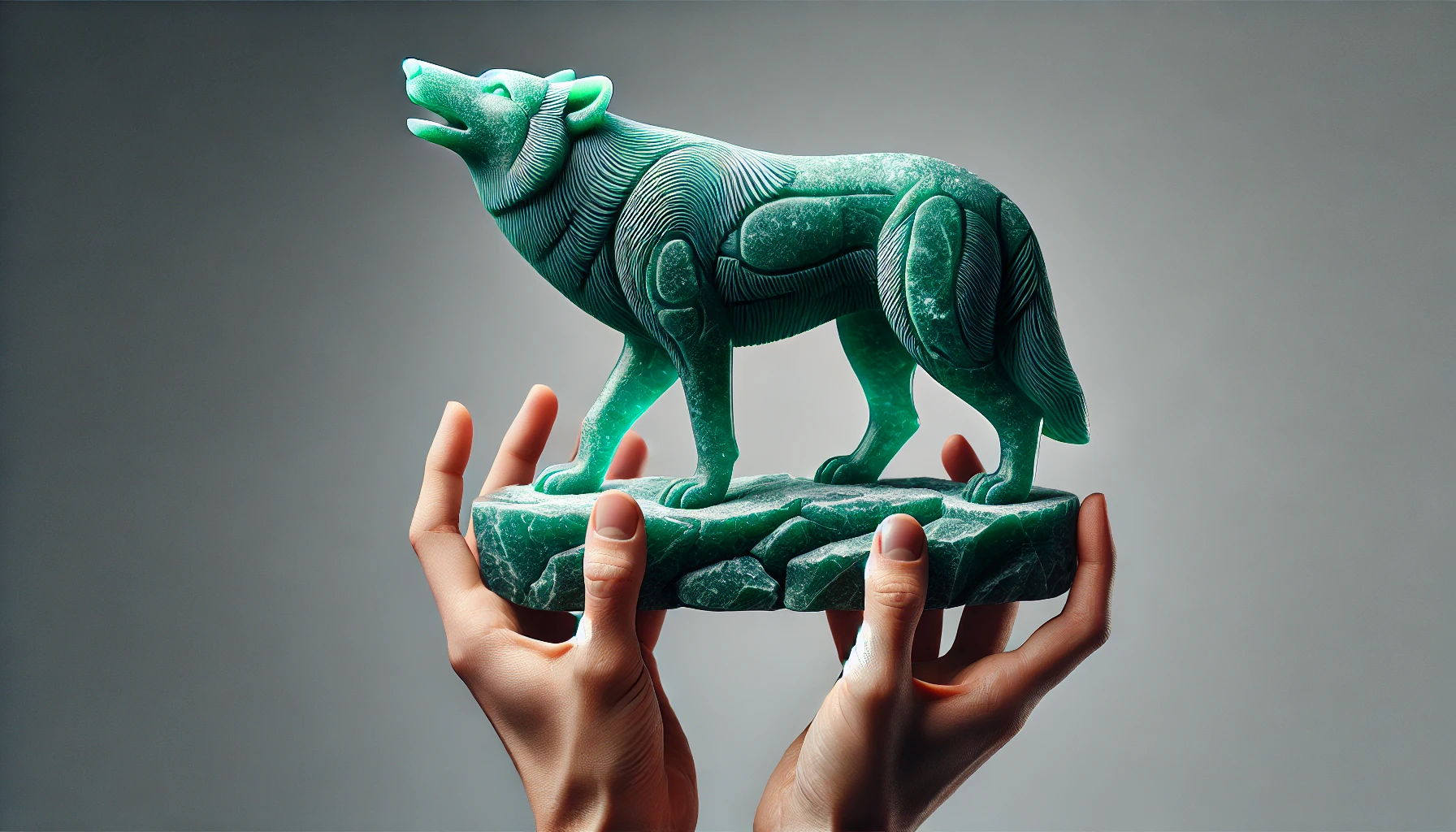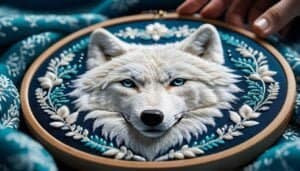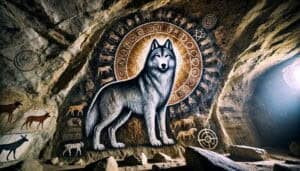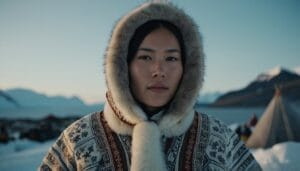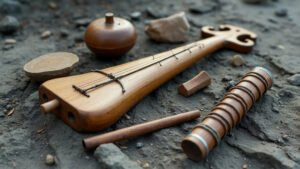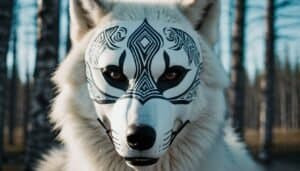Introduction
The Arctic wolf holds a significant place in Inuit culture and art, symbolizing resilience, survival, and the interconnectedness of nature and humanity
In modern Inuit art, the Arctic wolf is portrayed through a blend of traditional symbolism and contemporary techniques, reflecting both historical reverence and current environmental concerns
This article explores the cultural importance, artistic methods, notable artists, and thematic reflections related to the Arctic wolf in contemporary Inuit art
Cultural and Symbolic Importance of the Arctic Wolf
The Arctic wolf is a powerful symbol in Inuit culture, representing strength, survival, and the deep connection between the Inuit people and their natural environment
This section delves into the historical significance, symbolic meanings, and rich narratives surrounding the Arctic wolf in Inuit culture and art
Historical Significance in Inuit Culture
The Arctic wolf has been a part of Inuit life for centuries, playing a crucial role in their survival and cultural practices. Traditionally, the Arctic wolf was seen as both a fellow hunter and a spiritual guide
Inuit hunters observed and learned from the wolves’ hunting strategies, which were essential for their own survival in the harsh Arctic environment. The wolf’s ability to endure the extreme cold and navigate the frozen landscape resonated deeply with the Inuit, who shared similar challenges
Inuit mythology often includes the Arctic wolf as a central figure. These myths highlight the wolf’s role as a protector and a teacher. For instance, some stories depict wolves guiding lost hunters back to their communities or teaching them how to find food during lean times
These tales reinforce the respect and admiration the Inuit have for the Arctic wolf, seeing it as an integral part of their world and their survival
Symbolism in Traditional and Modern Art
Inuit art has long used symbolism to convey important cultural narratives, and the Arctic wolf is a prominent subject. Traditional carvings, masks, and drawings often depict wolves in dynamic poses, emphasizing their agility and strength
These representations are not merely artistic but are imbued with deeper meanings. The Arctic wolf is often a symbol of endurance and adaptability, traits highly valued in Inuit culture
In modern Inuit art, the symbolism of the Arctic wolf continues to evolve. Contemporary artists blend traditional motifs with new artistic expressions, creating pieces that speak to both their heritage and the present day
For example, the wolf might be depicted with elements of modern life or environmental changes, highlighting ongoing issues such as climate change and its impact on the Arctic ecosystem. This fusion of old and new serves to keep the cultural significance of the Arctic wolf relevant for current and future generations
Myths, Legends, and Stories
Inuit mythology is rich with stories featuring the Arctic wolf. These narratives often highlight the wolf’s intelligence, cooperation, and spiritual significance. One common legend tells of a great white wolf that leads hunters to safety during blizzards, symbolizing guidance and protection
Another tale describes a wolf that transforms into a human to teach the Inuit important lessons about community and survival
These stories are not only passed down through oral tradition but are also captured in various forms of art. Sculptures, prints, and tapestries often depict scenes from these legends, serving as both artistic expressions and educational tools. Through these artworks, the myths and legends of the Arctic wolf are preserved and shared, ensuring that their cultural lessons continue to be part of Inuit life
Artistic Techniques and Materials
The depiction of the Arctic wolf in Inuit art is characterized by a blend of traditional craftsmanship and modern innovation. This section explores the techniques and materials used by Inuit artists to bring the Arctic wolf to life in their art
Traditional Techniques and Materials
Traditional Inuit art is renowned for its meticulous craftsmanship and the use of natural materials readily available in the Arctic environment
These materials include stone, bone, ivory, and wood, which are skillfully transformed into intricate carvings, masks, and sculptures. Each material offers unique properties that influence the final artwork
Stone carvings, often made from soapstone or serpentine, are a staple of traditional Inuit art. Artists use hand tools to carve and polish the stone, creating smooth and detailed representations of Arctic wolves. These stone carvings can range from small, handheld pieces to larger, more complex sculptures. The weight and texture of the stone add a tactile quality that enhances the viewer’s connection to the piece
Bone and ivory carvings, primarily sourced from whales, walruses, and caribou, are another traditional medium. These materials allow for fine detail work, making them ideal for smaller, more delicate pieces
Inuit artists use these carvings to depict the Arctic wolf in various poses and expressions, capturing the animal’s essence and spirit. The use of these organic materials also reflects the Inuit’s deep respect for and relationship with their environment
Wood, though less commonly used due to its scarcity in the Arctic, also plays a role in traditional Inuit art. Driftwood, in particular, is often employed to create masks and other ceremonial objects. These wooden pieces are typically painted and adorned with other natural materials, such as feathers and fur, to enhance their visual impact and cultural significance
Modern Methods in Inuit Art
Modern Inuit artists have embraced new techniques and materials to expand their artistic expression while still honoring traditional methods. Contemporary tools, such as electric carving tools and power sanders, have made the carving process more efficient, allowing artists to experiment with more intricate designs and larger scales
In addition to traditional carving, many Inuit artists now incorporate printmaking and painting into their repertoire. Printmaking, particularly stonecut and stencil techniques, has become a popular medium for depicting the Arctic wolf
These prints often feature bold lines and contrasting colors, emphasizing the wolf’s form and presence. The use of modern inks and printing techniques allows for vibrant and lasting artworks that can be reproduced and shared more widely
Painting, both on canvas and traditional materials, has also gained prominence. Contemporary Inuit painters use a variety of styles, from realistic to abstract, to portray the Arctic wolf. These paintings often explore themes of identity, environment, and cultural heritage, providing a modern perspective on traditional subjects
Acrylics, watercolors, and mixed media are commonly used, offering artists a broad palette to express their visions
Use of Natural and Contemporary Materials
Inuit artists continue to use natural materials, such as stone, bone, and wood, but they also incorporate contemporary materials to enhance their work. These modern materials include metal, glass, and synthetic paints, which offer new possibilities for texture, color, and form
Metal, for instance, is used in jewelry and small sculptures to add a sleek, modern touch. Artists may combine metal with traditional materials, creating a contrast that highlights the unique qualities of each. Glass, another contemporary addition, is often used in combination with stone or metal to create striking, multi-dimensional pieces
Synthetic paints and finishes provide a broader range of colors and effects, allowing artists to experiment with new styles and techniques. These materials enable more vibrant and durable artworks, which can withstand the harsh Arctic climate and be displayed in various settings, from galleries to outdoor installations
Influential Inuit Artists and Their Works
The depiction of the Arctic wolf in Inuit art has been shaped by many talented artists who bring their unique perspectives and skills to their work. This section highlights some of these influential artists, their inspirations, and the evolution of their artistic styles
Artists Known for Arctic Wolf Depictions
Several Inuit artists are renowned for their depictions of the Arctic wolf, each contributing their unique style and interpretation. One prominent artist is Kenojuak Ashevak, whose work often features wildlife, including the Arctic wolf, in vibrant and dynamic compositions
Ashevak’s use of bold colors and intricate patterns has made her one of the most celebrated Inuit artists
Another notable artist is Tim Pitsiulak, known for his detailed drawings and prints that capture the essence of Arctic wildlife. Pitsiulak’s work often reflects his deep connection to the natural world, with the Arctic wolf being a recurring subject. His realistic yet expressive style brings the animal’s character to life, emphasizing its importance in Inuit culture
Karoo Ashevak is also significant in this realm, though his medium is different. His sculptures, often carved from whalebone, depict the Arctic wolf in various forms and sizes. Ashevak’s work is known for its raw, expressive quality, which captures the spirit and power of the wolf in a tangible way
Inspirations Behind the Art
The inspirations behind these artists’ works are deeply rooted in their cultural heritage and personal experiences. Many Inuit artists draw from their own interactions with the Arctic environment and its wildlife. The Arctic wolf, in particular, is a symbol of strength and survival, qualities that resonate deeply with the Inuit people
For instance, Kenojuak Ashevak often drew inspiration from her surroundings and the traditional stories passed down through generations. Her vibrant depictions of the Arctic wolf are not just artistic expressions but also cultural narratives that preserve and celebrate Inuit traditions
Tim Pitsiulak’s work was heavily influenced by his experiences as a hunter and fisherman. His intimate knowledge of Arctic wildlife and the landscape allowed him to create works that are both accurate and emotionally resonant. The Arctic wolf, in his art, is portrayed with a respect and understanding that reflects its role in the natural world and Inuit culture
Karoo Ashevak’s sculptures are inspired by traditional Inuit beliefs and myths. His use of whalebone and other natural materials connects his work to the land and its history. The Arctic wolf in his sculptures often embodies spiritual themes, serving as a bridge between the physical and the spiritual realms
Evolution and Current Trends
The portrayal of the Arctic wolf in Inuit art has evolved over time, reflecting changes in both artistic techniques and cultural contexts. Traditional methods and materials continue to play a vital role, but contemporary artists are increasingly incorporating modern influences and addressing current issues
In recent years, there has been a growing trend towards environmental themes in Inuit art. Artists are using their work to highlight the impact of climate change on the Arctic ecosystem and its wildlife, including the Arctic wolf
This shift not only brings attention to critical issues but also demonstrates the adaptability and relevance of Inuit art in addressing modern concerns
Additionally, the influence of global art movements and technologies has led to new styles and mediums in Inuit art. Digital art, mixed media, and experimental forms are becoming more common, allowing artists to reach broader audiences and explore new creative possibilities
Despite these changes, the core elements of Inuit art—its connection to nature, cultural heritage, and storytelling—remain strong
Themes and Environmental Reflections in Art
The Arctic wolf’s depiction in Inuit art is rich with themes that resonate deeply with the Inuit people’s relationship with their environment and cultural heritage
This section explores the common themes associated with the Arctic wolf and how environmental concerns are reflected in contemporary Inuit art
Recurring Themes with Arctic Wolves
The Arctic wolf is often portrayed in Inuit art with themes of strength, resilience, and survival. These themes are integral to the Inuit way of life, reflecting their adaptation to the harsh Arctic environment. The wolf’s ability to thrive in extreme conditions makes it a powerful symbol of endurance and perseverance
Another common theme is the interconnectedness of all living things. In many Inuit artworks, the Arctic wolf is depicted alongside other Arctic animals and natural elements, emphasizing the balance and harmony of the ecosystem
This theme highlights the Inuit belief in the interdependence of humans, animals, and the land
The Arctic wolf also embodies themes of guidance and protection. In Inuit mythology, wolves are often seen as guides or spiritual guardians. This protective aspect is frequently depicted in art, where the wolf is shown watching over human figures or leading them through the landscape
These representations reinforce the wolf’s role as a guardian and a symbol of wisdom
Environmental Awareness in Art
In recent years, environmental concerns have become a prominent theme in Inuit art, with the Arctic wolf serving as a poignant symbol of the changes affecting the Arctic region. Artists use their work to raise awareness about climate change, habitat loss, and the impact on wildlife
One way artists address these issues is by depicting the Arctic wolf in contexts that highlight environmental degradation. For instance, the wolf might be shown in a melting ice landscape, symbolizing the threat of global warming
These artworks serve as powerful visual statements, drawing attention to the urgent need for environmental conservation
Many Inuit artists also incorporate modern materials and techniques to reflect the changing environment. Mixed media pieces, for example, might combine traditional carving with contemporary elements like plastic or metal to symbolize the intrusion of human activity into natural spaces. These works challenge viewers to consider the impact of their actions on the fragile Arctic ecosystem
Contemporary Representation and Perception
The contemporary representation of the Arctic wolf in Inuit art continues to evolve, reflecting both traditional values and modern realities. Younger generations of Inuit artists are exploring new ways to portray the Arctic wolf, incorporating contemporary influences and addressing current issues
One trend is the use of digital art and new media to create dynamic and interactive pieces. Digital prints, animations, and virtual reality installations allow artists to reach a global audience and convey their messages in innovative ways
These modern representations often blend traditional symbolism with cutting-edge technology, offering fresh perspectives on the Arctic wolf and its significance
Another aspect of contemporary representation is the exploration of identity and cultural heritage. For many Inuit artists, the Arctic wolf is a means of expressing their connection to their ancestry and their land. These artworks often delve into personal and communal histories, using the wolf as a metaphor for cultural resilience and continuity
Artists like Annie Pootoogook and Shuvinai Ashoona, for example, have gained recognition for their unique styles and contemporary themes. Their work often reflects the intersection of traditional life and modern influences, portraying the Arctic wolf in ways that resonate with both Inuit and non-Inuit audiences
Conclusion
The Arctic wolf holds a significant and multifaceted role in modern Inuit art, symbolizing strength, resilience, and the deep connection between the Inuit people and their environment. Through the works of influential artists and the evolution of artistic techniques, the Arctic wolf continues to be a powerful emblem of cultural heritage and environmental awareness
From traditional carvings and sculptures to contemporary digital art and mixed media, Inuit artists use the image of the Arctic wolf to convey themes of endurance, guidance, and the interconnectedness of all living things
These artworks not only preserve and celebrate Inuit culture but also address pressing modern issues such as climate change and habitat loss. By blending traditional materials with contemporary influences, Inuit artists ensure that their cultural narratives remain relevant and impactful in today’s world
The Arctic wolf, depicted in various forms and contexts, remains a vital symbol in Inuit art, reflecting both the past and the present, and inspiring future generations to appreciate and protect the natural world
In summary, the Arctic wolf’s perception in modern Inuit art is a testament to the enduring strength of Inuit traditions and their ability to adapt and respond to contemporary challenges. The art that features this majestic animal serves as a bridge between the Inuit’s rich cultural history and their ongoing commitment to environmental stewardship and cultural resilience
Through their creative expressions, Inuit artists continue to honor the Arctic wolf’s legacy while engaging with the broader global community on issues that affect us all
